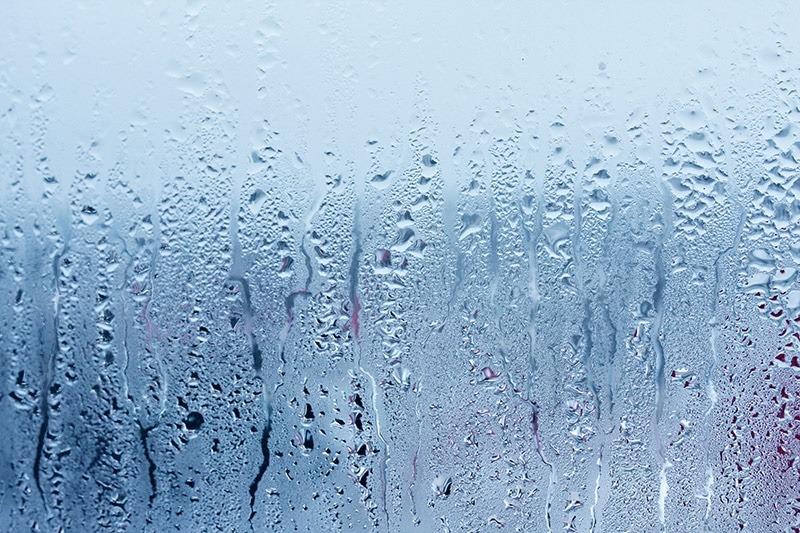High humidity in the home is not only uncomfortable, but it can also lead to moisture which poses a serious problem for your home’s structure and surfaces if left unchecked.
High humidity and moisture can destroy wood, siding, and insulation, making your home more prone to allergens and pollutants, including dust, mold, and mildew. These can be particularly devastating to your health, especially if you are an asthma sufferer.
To help you avoid this problem, we’ve put together our top five tricks to prevent moisture problems in the home.
How do you know that you have excess moisture in your home?
There are some telltale signs that indicate excess moisture in your home. These can include:
- Condensation on windows, mirrors, and pipes
- Wet stains or discoloration on the walls and ceiling
- The smell of mold or mildew
- Frequent sneezing or coughing from residents
Five tricks to prevent moisture issues in the home
Trick #1: Use a dehumidifier
Dehumidifiers are an effective solution to lower indoor humidity levels, especially if you need a quick and temporary fix. They can do away with stuffy air and mold growth as they keep the moisture in the air under control.
Most dehumidifiers are best installed in your basement and are most effective when the room is completely sealed off (this includes windows and doors). Dehumidifiers eliminate moisture from the air making everything more comfortable.
Trick #2: Improve the ventilation and insulation of your home
Exhaust fans and open windows, especially in tiny homes, allow the humid air to escape. Proper ventilation keeps indoor humidity levels down, and it’s important to clean your air conditioner filters regularly to ensure the airflow is running at an optimal pace.
An exhaust fan over your hot plates is just as important in the kitchen as a high-quality kitchen backsplash tile to protect this heavily used (and wet) area. Areas with moisture, most notably the kitchen and bathrooms, are the biggest focus when it comes to keeping things well ventilated. Turn on vents and leave them on until all of the moisture is out of the room. Additional fans may also be a good idea if you notice the existing vents aren’t as effective as they should be.
Along with this, it’s important to ensure your home is well insulated as this can prevent cool and warm air from entering or escaping through gaps in the walls. You can weather-strip the doors and windows of your home to create an airtight seal as well. This will prevent cool or warm air from escaping or any excess humidity flowing inside.
Trick #3: Turning on the air conditioner
It may sound easy enough, but this is very effective in reducing moisture. Your air conditioner acts in a similar way to a compressor dehumidifier removing moisture from the air. Hot, humid air comes into contact with the air conditioner’s cold coils, which both lower indoor humidity levels and keeps everything inside of the home cool.
It is important to note that this effect and the right amount of cooling for your house hinge on the air conditioning unit being the correct size when considering the square footage of your property.
Trick #4: Dry your clothes outdoors
It can be tricky during the winter, especially if it’s raining out, but drying clothes indoors during the colder months traps moisture indoors. Try drying your clothes outdoor or using a dryer that can channel its hot, humid air outdoors.
Trick #5: Using desiccants
Desiccants, including silica gel, charcoal, and rock salt, absorb moisture from the air due to their hygroscopic nature. For example, putting a basket of charcoal in a room will pull the moisture from the air and keep the area a lot dryer. Simply replace the charcoal when it gets damp to keep a consistent level of dryness in the room. You can even reuse the damp charcoal by drying it under the sun or in an oven. This way, you can rotate two baskets and minimize the waste.
Prevention is always better than a fix
Moisture issues are better prevented than repaired (the more costly option). The methods above will certainly help with prevention, but the first option, a dehumidifier, is an essential household appliance if you start noticing signs of high indoor humidity.
Do your best to keep surfaces dry by wiping down kitchen and bathroom areas after use to prevent evaporating water from gathering in the air and dry wet floor mats and towels so that they don’t become a source of humidity indoors. If you keep on top of it, you’ll avoid the very annoying moisture issues that can cause bigger problems down the track.








